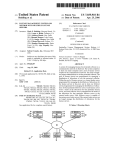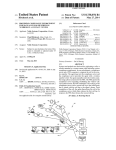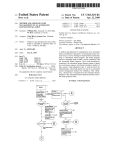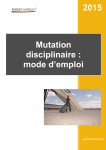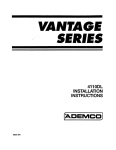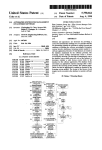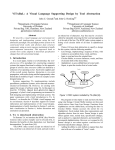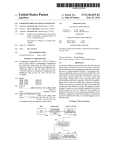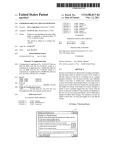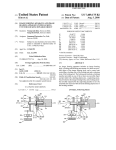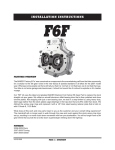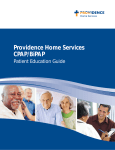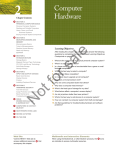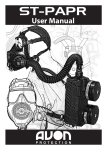Download License management system and method for commuter licensing
Transcript
US006968384B1
(12)
(54)
(75)
United States Patent
(10) Patent N0.:
Redding et al.
(45) Date of Patent:
Nov. 22, 2005
LICENSE MANAGEMENT SYSTEM AND
5,146,575 A
9/1992 Nolan, Jr.
METHOD FOR COMMUTER LICENSING
5,390,297 A
2/1995 Barber et 211.
Inventors; Mark E, Redding, Newport Beach, CA
(US); Logan A. Badia, Fullerton, CA
5,745,879 A
4/1998 Wyman
5,790,664 A *
8/1998 Coley et a1. .............. .. 709/203
5,862,348 A
1/1999 Pedersen
(US); Sandeep Handa, New Delhi
(IN); Hemant Sharma, Lake Forest,
(Continued)
CA US ; Sanjay Chopra, New Delhi
(IN; Rgna Gupta, H a ry a na (IN);
FOREIGN PATENT DOCUMENTS
Poonam La], Haryana (IN)
GB
2316503
(73) Assignee: Safenet, Inc., Belcamp, MD (US)
(*)
US 6,968,384 B1
_
_
Notice:
_
8/1996
OTHER PUBLICATIONS
_
_
PC Week, “Strength in Numbers”, vol. V3, Jul 1986, p. 57.
SubJect to any disclaimer, the term of this
patent is extended or adjusted under 35
(Continued)
U.S.C. 154(b) by 794 days.
(21) Appl- N05 09/ 648,502
Primary Examiner—Paul H. Kang
(74) Attorney, Agent, or Firm—Venable LLP
(22) Filed:
(57)
Aug. 25, 2000
ABSTRACT
Related US. Application Data
(60)
Provisional application No_ 60/152,785, ?led on Sep_
7, 1999_
A system for managing licenses for protected software on a
communication network is disclosed. The system includes at
least one client computer that is capable of being coupled to
(51)
Int. Cl.7 .................... .. G06F 15/16; G06F 15/173;
H04L 9/00
US. Cl. .................... .. 709/229; 709/225; 713/201;
705/52; 705/59
Field of Search .............................. .. 709/201, 202,
or decoupled from the communication network. While
coupled to the communication network, a user of the client
(52)
(58)
Computer may request a Commuter authorization to use the
protected software. At least one license server is also
coupled to the Communication network Each license Server
709/203, 217, 226, 229; 713/153, 160, 170,
is programmed for managing a distribution of allocations to
713/173, 185, 201; 705/52, 59
use the protected software. In addition, at least one of the
(56)
license servers is programmed for granting a commuter
authorization in response to a request for a commuter
authorization from a client computer if there is an available
authorization. After a commuter authorization is received by
References Cited
US PATENT DOCUMENTS
4,652,990 A
3/1987 Pa?en et a1_
a client computer, the client computer stores a commuter
4,658,093 A
4,685,055 A
4/1987 Hellman
8/1987 Thomas
authorization lifetime representing a time period for which
the commuter authorization is valid. The client computer
may then use the protected software while coupled to or
decoupled from the communication network until the com
muter authorization lifetime expires.
4,754,395 A
47807821 A
4’791’565 A
6/1988 Weisshaaf 61 @1-
10/1988 Crossley
12/1988 Dunham et a1‘
4,796,220 A
1/1989 Wolfe
5,117,222 A *
5/1992 McCurdy et a1. ...... .. 340/5734
5,138,712 A
8/1992 Corbin
17 Claims, 4 Drawing Sheets
14\ LIC.SERVERA
g0{24\
22\
LIC.SERVERB /14
RLF
RLF
LM PROGRAM
LM PROGRAM
/24
L|C.SERVERC /14
RLF
10/>
12\
CLIENT1
CL|ENT2
PROGRAM
PROGRAM
18
/
18
__
CLIENTN
PROGRAM
/
18
/24}20
LM PROGRAM f2?
12
US 6,968,384 B1
Page 2
US. PATENT DOCUMENTS
5,970,143 A *
6,101,606
A
*
2002/0161718 A1*
10/1999
8/2000
Schneier et al. .......... .. 713/181
Diersch et al.
.....
. . . ..
713/201
10/2002 Coley et al. ................ .. 705/59
OTHER PUBLICATIONS
Digital Review, “Apollo Licenses Concurrent Users on
Entire Network”, vol. 4, No. 20, Oct. 26, 1987, p. 6.
IBM Technical Disclosure Bulletin, “Software Serial
Number”, vol. 26, No. 7B, Dec. 1983, pp. 3918-3919.
Chovan, J ., “Handling Site-License Agreements and Public
Domain Software Packages: What are the Issues?”, ACM
SIGUCCS Conference, Toledo, Ohio, Sep. 30-Oct. 4, 1985,
pp. 175-179.
Brown, B., “Microcomputer Software EXchange at
Michigan State University”, ACM SIGUCCS Conference,
Toledo, Ohio, Sep. 30-Oct. 4, 1985, pp. 185-197.
Halaris, A., Sloan, L., “Networked Microcomputers: New
Challenges For Computing Center Management”,
SIGUCCS Newsletter, vol. 13, No. 4, Winter 1983, pp.
20-26.
Gerber, H., Pringle, G., “Instructional Computing and Local
Area Networking”, SIGUCCS Newsletter, vol. 17, No. 2,
Summer 1987, pp. 8-13.
KreutZer, A., “An On-Line System For Controlling and
Monitoring Software Usage in a Microcomputer Labora
tory”, SIGUCCS Newsletter, vol. 18, No. 2, Summer 1988,
pp. 29-32.
Houy, T., “The Challenge of Selling Software on the
Internet”, Electronic Software Distribution: White Paper,
http://www.elan.com/corp/esd.htm, Nov. 4, 1997, pp. 1-6.
IFOR/LS and EZ-LoK FAQ Product Information, http://
www.gradient.com/support/techfaq/ifor/eZlok/eZprod.htm,
Nov. 7, 1997, pp. 1-3.
Harper, Jr., R., “Software Licensing For Installations With
Multiple Microcomputers”, Abstract No.: C86000243,
Computers & Education, 1985, vol. 9, No. 3, 1 page.
Cooper, F. et al., “Software Protection and Pricing in a LAN
Environment”, Abstract No. C86032120, Jurimetrics
Journal, Winter 1986, vol. 26, No. 2, 1 page.
Rainbow
Technologies,
“Sentinel
License
Manager—Getting Started—for Windows TCP/IP and
Novell NetWare—Release 5.0”, 1997, pp. i-v, 1-24.
Rainbow Technologies, Notice for SentinelLM 5.0 UNIX
Customers, 1997, 1 page.
Rainbow
Technologies,
“Sentinel
License
Manager—Integrator’s Guide for NetWare—Release 5.0”,
1997, pp. i-vi to IN-10.
Rainbow
Technologies,
“Sentinel
License
Manager—System
Administrator’Guide
for
NetWare—Release 5.0”, 1997, pp. i-1 to IN3.
Rainbow
Technologies,
“Sentinel
License
Manager—Reference Manual—Release 5.0”, 1997, pp. i-1
to IN12.
Rainbow
Technologies,
“Sentinel
License
Manager—Integrator’s Guide for UNIX—Release 5.0”,
Allen, K, “Software Lending Library”, ACM-SIGUCCS
1997, pp. i-1 to IN10.
XII, Conference Proceedings, Nov., 1984, pp. 171-172.
Rainbow
Technologies,
“Sentinel
License
Manager—System Administrator’s Guide for INIX—5.0”,
InfoWorld, “FST Introduces a Copy Protection Scheme For
Nets”, vol. 7, No. 7, Nov. 25, 1985, p. 14.
Micro Communications, “Software Protection” , vol. 2, No.
5, May, 1985, pp. 35-37.
PC World, “LAN Licensing Lags”, vol. 3, No. 11, Nov.
1985, pp. 320, 324, 328.
Rifkin, A. et al, “RFS Structural Overview”, USENIX
Summer Conference Proceedings, Atlanta, Ga., Jun. 9-13,
1986, pp. 248-259.
Gould, E., “The Network File System Implemented on
4.3BSD”, USENIX Conference, Atlanta, Ga., Jun. 9-13,
1986, pp. 294-298.
Software News, “The Promise of LANS: MIS Back in
Control”, pp. 51-54, 56-58.
IBM Technical Disclosure Bulletin, “Device/Pro?le Instal
lation Procedure with Validation”, vol. 28, No. 4, Sep. 1985,
p. 1487.
The DEC Professional, “PACS Plus Relief for VAX/VMS
1997, pp. i-1 to IN4.
Rainbow
Technologies,
“Sentinel
License
Manager—Integrator’s Guide for Windows TCP/
IP—Release 5.0”, 1997, pp. i-1 to IN12.
Rainbow
Technologies,
“Sentinel
License
Manager—System Administrator’s Guide for Windows
TCP/IP—Release 5.0”, 1997, pp. i-1 to IN3.
Rainbow
Technologies,
“Sentinel
License
Manager—Integration Guide—Release 6.0”, 1998, pp. i to
130.
Rainbow
Technologies,
“Sentinel
License
Manager—Programmer’s Reference Manual—Release 6.
0”, 1998, pp. i to 187.
Rainbow
Technologies,
“Sentinel
License
Manager—System Administrator’s Guide—Release 6.0”,
1998, pp. i to 62.
Rainbow Technologies, “Notice for SentinelLM 6.0 UNIX
Software”, vol. 15, No. 4, Winter 1985, pp. 9-12.
Customers”, Mar. 6, 1998, pp. 1, 2.
Rainbow Technologies, “SentinelLM License Management
System, Release 6.1, Release Notes”, Jan. 15, 1999, pp. 1-7.
Rainbow Technologies, “Sentinel Engineering Product
Release Notes, SentinelLM License Management System”,
Version No. 6.1, Aug. 13, 1998, pp. 1-7.
AMC-SIGUCCS User Services Conference IX, “A Software
Rainbow Technologies, “Notice for SentinelLM 6.1 UNIX
Management System”, Atlanta, Ga., Oct. 11-14, 1981, pp.
Customers”, Sep. 18, 1998, pp. 1, 2.
Rainbow Technologies, “SentinelLM License Manager,
System Administrator’s Guide, Releae 6.1”, 1998, pp. i-61.
Rainbow Technologies, “SentinelLM License Manager,
Developer’s Integration Guide, Release 6.1”, 1998, pp.
Resource Management Headaches”, Feb. 1986, pp. 58-62,
64.
Software News, “LAN Applications Prices Are Not Easy to
Set”, Apr. 1987, pp. 54, 56, 58.
SIGUCCS Newsletter, “Licensing of Microcomputer
9-17.
Brooks, C., “Experiences with Electronic Software Distribu
tion”, USENIX Summer Conference, Portland, Oregon, Jun.
11-14, 1985, pp. 433-436.
Leiss, E., “On AuthoriZation Systems with Grantor
Controlled Propagation of Privileges”, CompCon 83, San
Francisco, CA, Feb. 28-Mar. 3, 1983, pp. 499-502.
i-164.
Rainbow Technologies, “SentinelLM License Manager,
Evaluation Guide, Release 6.1”, 1998, pp. i-23.
US 6,968,384 B1
Page 3
Rainbow Technologies, “SentinelLM License Manager,
Programmer’s Reference Manual, Release 6.1”, 1998, pp.
Common Licensing API, “License Service Application
Programming Interface, API Speci?cation v1.02”, Jan. 28,
i-191.
1993, RTI 3389-3413- pp. i-22.
Rainbow Technologies, “SentinelLM License Manager,
SentinelLM Developer’s Guide, Release 6.1”, 1998, pp.
Auto-Trol Technology Corp., “Auto-Trol SoftWare Protec
tion Installation Guide”, Apr. 4, 1986, FF00016-00025, 10
i-127.
RainboW Technologies, “Notice for SentinelLM UNIX
pages.
Customers: Installing from CD”, Feb. 26, 1999, pp. 1, 2.
RainboW Technologies, SentinelLM License Management
System, Release 6.2, Release Notes, Feb. 12, 1999, p. 1-11.
RainboW Technologies, “Notice for SentinelLM 6.1 UNIX
Tandem Customers”, Feb. 16, 1999, pp. 1, 2.
RainboW Technologies, “Notice for SentinelLM 6.1 UNIX
Customers”, Sep. 23, 1998, pp. 1, 2.
Elan Computer Group, “Comparing Elan License Manager
With other softWare license managers”, White Paper, Jun. 15,
1995, pp. 1-5.
Elan Computer Group, “Elan License Manager, Questions
and Answers”, Aug. 1995, G 0002556-0002562, pp. 1-6.
Elan Computer Group, “Elan License Manager, Technical
Overview”, Jul. 1995, G 0002546-0002555, pp. 1-9.
Elan Computer Group, “Elan License Manager, Integrator’s
Guide for WindoWs, Release 5 .0”, rev. Jan. 31, 1997, ELAN
002589-002597, pp. i-viii.
Elan Computer Group, “Elan License Manager, System
Administrator’s Guide for WindoWs, Release 5 .0”, rev. Jan.
31, 1997, ELAN 002598-002602, pp i-iv.
Elan Computer Group, “Elan License Manager, Reference
Manual, Release 5.0”, rev. Jan. 31, 1997, elan 002603
002609, pp. i-vi.
Elan Computer Group, Elan License Manager Technical
OvervieW, Nov. 13, 1997, ELAN 001702-001757, pp. 1-9;
1-2, i-iii, 1-44.
Highland SoftWare, Inc., “FLEXlm End User/Programmers
Manual”, Mar. 8, 1991, BP 00022-BP 00037, pp. 1-3, 9-11,
19-21, A1-A3, 45, 61, 62, 84, 85.
Auto-Trol Technology Corp., “FLEXlm Programmers
Guide, Dec. 1994”, BP 00098-000137, pp. 1-36, 1-4.
Highland SoftWare, Inc., “FLEXlm License Manager,
Technical OvervieW”, Oct., 1991, 8 pages.
Globetrotter SoftWare, Inc., FLEXlm Programmers Guide
for WindoWs, Version 5.11, Mar. 1997, RTI 5219-5290, pp.
i-65.
Globetrotter SoftWare, Inc., FLEXlm End User Manual,
Version 6.0, Oct. 1997, RTI5129-5217, pp. 1-80.
Globetrotter SoftWare, Inc., FLEXlm Refernce Manual, Ver
sion 6.0, Dec. 1997, RTI5291-5508, pp. i-206.
Globetrotter SoftWare, Inc., FLEXlm Reference Manual,
Version 6.1, Jan. 21, 1999, RTI5509-5942.
PCT International Search Report as issued in International
Application No. PCT/US00/24359, Mailing Date Aug. 2,
2001.
* cited by examiner
U.S. Patent
Nov. 22,2005
14\ LIC.SERVERA
20{24\
22\
Sheet 1 of4
US 6,968,384 B1
, LIC.SERVERB /14
RLF
RLF
LM PROGRAM
/24
LM PROGRAM f2?
10/>
L|C.SERVERC /14
RLF
1-6
12
/
12\
CL|ENT1
CLIENT2
CLIENTN
PROGRAM
PROGRAM
PROGRAM
/
18
/
1s
/
18
24\ REDUNDANT LICENSE FILE
26/LICENSE CODE A
QB/LICENSE CODE B
26/LlCENSE CODE 0
LlCENSECODE26/{ R1 | R2 | R3 | "'1 RN l
FIG. 3
/24}20
LM PROGRAM /22
/12
U.S. Patent
Nov. 22,2005
Sheet 4 0f 4
US 6,968,384 B1
LIC.SEVER
14
1A
14
/
RLF
LM PROGRAM 6/22
UTILITY -/62
5&5 i8
12CL|ENT
PROGRAM /50
_/’52
515 3 5Q
UTILITY /54
FIG. 8
US 6,968,384 B1
1
2
LICENSE MANAGEMENT SYSTEM AND
METHOD FOR COMMUTER LICENSING
advance of usage of the encrypted program. Accordingly,
such techniques can be prohibitively inconvenient for some
computer and netWork environments, Where it is dif?cult or
impractical to supply each authoriZed user With a decryption
CROSS-REFERENCE TO RELATED
APPLICATIONS
program or key or to decrypt a program for each user or
usage.
Other softWare protection techniques have required legiti
Embodiments of the present invention claim priority from
Provisional Application Ser. No. 60/152,785, ?led Sep. 7,
1999, and are related to US. utility patent applications
entitled “License Management System And Method With
Multiple License Servers”, Ser. No. 09/648,697, ?led Aug.
25, 2000; “License Management System And Method With
License Balancing”, Ser. No. 09/648,720, ?led Aug. 25,
2000; and “System And Method For Selecting A Server In
A Multiple Server License Management System”, Ser. No.
09/648,853, ?led Aug. 25, 2000. The contents of each of
these applications are incorporated by reference herein.
mate or authoriZed users to have a special hardWare device
10
or circuit installed in or plugged into their computer, prior to
usage of the protected softWare. See, e.g., US. Pat. No.
4,446,519 to Thomas. Again, such techniques can be pro
hibitively inconvenient for some computer and netWork
environments. For eXample, if the netWork environment is
such that the authoriZed user must use multiple computers
15
on the netWork, then each computer must be provided With
the special hardWare device. Moreover, if the environment is
such that computers having the special hardWare device are
not located in secure facilities, then unauthoriZed users may
BACKGROUND OF THE INVENTION
20
1. Field of the Invention
The present invention relates, generally, to license man
agement systems and processes for managing licenses on a
computer netWork and, in preferred embodiments, to such
systems and processes involving a pool of license servers for
25
managing softWare licenses among one or more users on the
netWork, and for granting authoriZations to use protected
softWare programs to client computers that may become
temporarily disconnected from the netWork.
2. Description of Related Art
The increasing popularity of computer usage in homes
and businesses, as Well as in governmental, research and
education institutions, has brought about a World-Wide
demand for greater softWare variety and sophistication.
Indeed, the softWare development industry in most indus
trialiZed countries has shoWn substantial groWth in recent
years and is eXpected to shoW continued groWth through the
30
tems operate With a license server connected to a netWork of
users. The license server stores and manages softWare
licenses for the network users, in accordance With a license
management program stored on the server. Each copy of a
35
protected softWare program on the netWork is accompanied
by a program code corresponding to a shell (also knoWn as
“Wrapper”) or library of Application Program Interface
(API) functions, Which communicates With the license man
neXt decade.
agement program on the server. When a user starts to run the
HoWever, as softWare sophistication increases, develop
ment costs associated With such softWare also tend to
increase. Modern softWare programs can require months or
be able to access the protected softWare by using the
non-secure computer in Which the special hardWare device
is installed.
Accordingly, more sophisticated license management
softWare has been developed for managing softWare licenses
for computer netWorks, Which do not require encryption of
the protected softWare or special hardWare devices in each
authoriZed user’s computer. For eXample, the assignee of the
present invention, RainboW Technologies, Inc., has mar
keted versions of a license management system under the
trademark, SENTINELLMTM. The SENTINELLMTM sys
40
protected softWare program, the shell code or library of API
functions provided With the program communicates a
request to use a license to the license server, over the
even years of development, often involving expensive
netWork. The server, under the control of the license man
resources and teams of highly skilled engineers and pro
agement softWare, responds to the request to determine
Whether it is storing an available license for the protected
grammers, before a product may be readied for sale or
license. Thus, softWare development companies are often
required to make large investments early in the development
of their products, in the hope that the products Will provide
45 softWare program. If so, the server communicates an autho
riZation message to the user and decrements a count of
available licenses stored by the server. If not, the server
communicates another message to the user, indicating that
a volume of sales or license revenues suf?cient to cover their
development investments and generate pro?ts.
no licenses are available. In this manner, licenses are alWays
Illegal softWare usage and piracy have become a signi?
cant problem to softWare development companies. Because
of the nature of computer softWare, illegal usage and illegal
copying of proprietary softWare programs can be dif?cult to
detect or deter. The increasing usage of computer netWorks
has added to the problem. Computer netWorks can alloW
50 stored and managed on a netWork license server. Each
multiple users to access and copy softWare stored by a
by unauthoriZed or unlicensed users having access to the
With respect to the freedom to readily add, delete or change
authoriZed users on the netWork, and the ability to readily
control and alter licensing schemes (for eXample, to add or
delete licenses or change conditions for licenses) by modi
fying only the license server ?les or programs. HoWever, if
all licenses are stored and managed in a single license server,
netWork.
failure of that server can result in a failure of the entire
Various forms of encryption techniques have been devel
oped to inhibit usage of encrypted softWare by unauthoriZed
license management system. Accordingly, prior versions of
netWork user may have a copy of a protected softWare
program, but must communicate With the license server for
authoriZation to use the protected program.
License management systems Which employ a license
55
common network program server or copy and pass softWare
betWeen each other, over the netWork. A legitimately pur
chased or licensed copy of a softWare program available on
a netWork could result in many illegitimate usages or copies
60
server, as discussed above, provide signi?cant advantages
the SENTINELLMTM systems include multiple license
users that do not possess a decryption program or key. 65 server capabilities, Wherein tWo or more license servers are
HoWever, such techniques typically require each authoriZed
provided on the netWork, each having a pre-loaded license
users to obtain or be passed a decryption program or key, in
?le and a license management program. One of the servers
US 6,968,384 B1
3
4
may be designated as a primary license server, While the
others are designated as backup servers. If the primary
server cannot be reached by a user, for example, because the
primary server has crashed or otherWise gone doWn, the user
a communication netWork. The system includes at least one
client computer that is capable of being coupled to or
decoupled from the communication netWork. While coupled
may then communicate With a backup server to obtain an
authoriZation message. The backup server, having a pre
loaded copy of the license ?le and the license management
program, may then take over the license management func
tions.
Alternatively, in other prior versions of SENTINELL TM
systems, a shell program or library ofAPI functions could be
con?gured to send a general poll to all servers coupled to the
communication channel on Which the poll is sent. In
response to a general poll, any server computer having a
10
license ?le containing license information corresponding to
the protected softWare program (Whether or not the license
15
information indicated that a license is available) Would send
a reply to the requesting client computer. The shell program
or library of API functions associated With the requesting
embodiments of the invention Will be apparent to those
skilled in the art from the folloWing detailed description of
received from a license server having a license ?le storing
license information for the protected softWare program. If
embodiments of the invention, When read With the draWings
and appended claims.
the replying license server contains an available license for
25
system provides a degree of protection against system
goes doWn. The doWn server computer Would not respond to
the poll, but other server computers having appropriate
contained in an RLF of FIG. 2 according to an embodiment
license information in their license ?le Would respond to the
35
authoriZation to run the protected softWare program, even
though one of the servers Was doWn.
While the above SENTINELLMTM systems have operated
of the present invention.
40
FIG. 5 is a generaliZed representation of an initial state of
distribution tables of leader server A and folloWer servers B
and C in a server pool comprising three license servers
according to an embodiment of the present invention.
FIG. 6 is a generaliZed representation of distribution
management systems for computer netWorks.
SUMMARY OF THE DISCLOSURE
of the present invention.
FIG. 4 is a generaliZed representation of a license code
contained in an RLF and copied into a license table and a
distribution table Within a single license server for the
netWork environment of FIG. 1 according to an embodiment
Well in many contexts, each license server operates some
What independent of other license servers. Accordingly,
there is a need in the industry for improvements in connec
tion With management and coordination of multiple license
servers (or a pool of license servers) in softWare license
BRIEF DESCRIPTION OF THE DRAWINGS
FIG. 1 is a generaliZed block diagram representation of an
example netWork environment according to an embodiment
of the present invention.
FIG. 2 is a generaliZed representation of a redundant
license ?le (RLF) for the netWork environment of FIG. 1
according to an embodiment of the present invention.
FIG. 3 is a generaliZed representation of a license code
failure, in the event that one of the license servers crashes or
poll, thus, alloWing the client computer to continue to seek
tion lifetime representing a time period for Which the
commuter authoriZation is valid. The client computer may
then use the protected softWare While coupled to or
decoupled from the communication netWork until the com
muter authoriZation lifetime expires.
These and other objects, features, and advantages of
client computer Would then respond to the ?rst reply
the protected softWare program, the replying license server
provides an authoriZation message to the requesting client
computer. If the replying license server does not contain an
available license for the protected softWare program, the
replying license server provides a message to the requesting
client computer indicating that authoriZation to run the
protected softWare program has not been granted. Such a
to the communication netWork, a user of the client computer
may request a commuter authoriZation to use the protected
softWare. At least one license server is also coupled to the
communication netWork. Each license server is programmed
for managing a distribution of allocations to use the pro
tected softWare. In addition, at least one of the license
servers is programmed for granting a commuter authoriZa
tion in response to a request for a commuter authoriZation
from a client computer if there is an available authoriZation.
After a commuter authoriZation is received by a client
computer, the client computer stores a commuter authoriZa
45 tables of leader server A and folloWer servers B and C in a
server pool comprising three license servers in the example
of FIG. 5 after an authoriZation has been granted by folloWer
Therefore, it is an advantage of embodiments of the
present invention to provide a license management system
and method for more ef?ciently managing licenses on a
server B according to an embodiment of the present inven
tion.
FIG. 7 is a generaliZed representation of the distribution
netWork using a pool of multiple license servers.
It is a further advantage of embodiments of the present
invention to provide a system and method for managing
server pool comprising three license servers in the example
of FIG. 6 after a commuter authoriZation has been granted
tables of leader server A and folloWer servers B and C in a
licenses on a netWork that alloWs a client computer to
request and receive a commuter authoriZation from a license
server While connected to the netWork, alloWing the client
by folloWer server C according to an embodiment of the
55
present invention.
FIG. 8 is a generaliZed block diagram representation of an
computer to run a protected softWare program even if the
example netWork environment illustrating the storing of
client computer should become disconnected from the net
Work.
It is a further advantage of embodiments of the present
invention to provide a system and method for managing
commuter authoriZation information according to
licenses on a netWork that alloWs a client computer to
request and receive a commuter authoriZation from a license
server While disconnected from the netWork, alloWing the
an
embodiment of the present invention.
DETAILED DESCRIPTION OF PREFERRED
EMBODIMENTS
In the folloWing description of preferred embodiments,
client computer to run a protected softWare program While
reference is made to the accompanying draWings Which
disconnected from the netWork.
65 form a part hereof, and in Which is shoWn by Way of
These and other advantages are accomplished according
to a system for managing licenses for protected softWare on
illustration speci?c embodiments in Which the invention
may be practiced. It is to be understood that other embodi
US 6,968,384 B1
5
6
ments may be utilized and structural changes may be made
RAM, for running a license management program as
described herein. In addition, each license server 14 is
coupled to one or more persistent program storage memory
devices 20, Which may include, but is not limited to, a hard
Without departing from the scope of the preferred embodi
ments of the present invention.
Preferred embodiments of the invention relate to a system
and process involving a pool of license servers for managing
licenses to, for example, one or more protected softWare
disc drive, ?oppy disc drive, tape drive, CD-ROM or the
like, having a computer readable medium on Which a license
programs, ?les or other data structures, among one or more
management program 22 and a redundant license ?le (RLF)
users on the netWork. Protected softWare may include, but is
not limited to, for example, a softWare program, such as a
Word-processing program, a graphics program, a computer
24 are stored.
10
game, etc., a proprietary ?le or other data structure, such as
a data-base or other form of data, as Well as other softWare
encoded information or instructions, for Which the control of
user access is desired. For purposes of simplifying the
present disclosure, the protected softWare used in the fol
15
An example embodiment of an RLF 24 is shoWn in FIG.
2 as containing license codes 26 for proprietary softWare
programs A, B, C, etc. Each license code 26, in one example
embodiment, comprises a string of data relating to license
policy and the softWare program to Which the license policy
applies. In preferred embodiments, license codes 26 for
softWare produced by more than one vendor may reside
loWing examples is one or more proprietary softWare pro
grams.
Within the same RLF 24 of the same license server 14, and
According to a preferred embodiment of the present
invention, the plurality of license servers are managed in
may be managed With a single process (execution of the
license management softWare) running on a single license
accordance With a server pool scheme, as controlled by a
server 14. Thus, any given licenser server 14 does not need
license management program associated With each license
server computer and the shell program or library of API
functions associated With each copy of the protected soft
Ware program. In preferred embodiments, the pool of license
to have multiple license management processes running to
manage licenses for multiple protected vendor applications.
Instead, only one license management program needs to be
running on a given license server 14, to manage licenses for
servers comprises three to 11 servers. HoWever, it should be 25
protected vendor applications managed by that license
noted that alternative embodiments of the present invention
server.
are not limited to any particular maximum number of license
servers. In addition, in further alternative embodiments,
In the example embodiment of FIG. 3, a license code 26
comprises a data string de?ning multiple records or ?elds
multiple pools of license servers can reside on a single
R1, R2, R3 . . . RN, Wherein each record corresponds to an
netWork. In further alternative embodiments only a single
license server is required for issuing commuter authoriZa
attribute associated With the license policy, the softWare
program to Which the license policy applies, or other infor
tions. HoWever, for purposes of illustration only, embodi
mation. In preferred embodiments, each license code 26
ments of the present invention Will be described herein With
includes at least one attribute associated With a license
reference to a pool of three license servers.
policy, the number of allocations for using the protected
An example hardWare environment for an embodiment of
35
reference to FIG. 1, a computer netWork 10 includes a
plurality of user or client computers 12 and three license
program is the maximum number of users that can be
servers 14, each coupled for communication over a com
munication netWork link, generally referenced at 16. The
plurality of client computers 12 are identi?ed as “Client 1”,
“Client 2”, and “Client N”, and the plurality of license
softWare program, and at least one other attribute associated
With the identity of the protected softWare program. The
number of allocations for using the protected softWare
the present invention is illustrated, generally, in FIG. 1. With
40
servers 14 are labeled as “Lic. Server A”, “Lic. Server B”,
and “Lic. Server C.” Embodiments may employ any suitable
number of client computers 12 and any suitable number of
license servers 14. Also, While not shoWn in FIG. 1, the
netWork 10 may include additional components, including
running the protected softWare program at any one time, and
is also referred to as the ceiling or hard limit. In preferred
embodiments, license code 26 also includes a ?ag Which
determines if commuter licensing functionality, described
herein, is enabled or disabled for the corresponding pro
tected softWare program. This ?ag alloWs the softWare
developer to make commuter licensing available only to
selected customers. Data associated With a license policy
preferably includes data representing the expiration date or
expiration time of the license, as granted by the licensee
(e.g., the protected softWare program’s oWner or developer).
For purposes of illustration only, in the example of FIG.
one or more program or ?le servers, routers and/or other
Well knoWn netWork devices and resources.
Each client computer 12 preferably includes a suitable
processor and associated transient memory, such as a RAM,
for running a protected softWare program. The client com
4 only one ?ctional license code 26, identi?ed as “Appli
cation v1.0,” is stored in the RLF 24 of a license server 14,
puter may be part of a standard personal computer (PC),
With a hard limit of 100 total allocations distributable across
netWork terminal, Workstation or the like. In one preferred
embodiment, each client computer 12 is coupled to a per
55
sistent program storage memory device 18, Which may
include, but is not limited to, a hard disc drive, ?oppy disc
drive, tape drive, CD-ROM or the like, having a computer
readable medium on Which the protected softWare program
is stored. Also stored as part of the protected softWare
IP address 32 for each license server 26. Another attribute of
the RLF 24 is the distribution of the 100 allocations across
all the license servers 14. This distribution is identi?ed as the
initial distribution 30, and is con?gurable by the netWork
administrator. In the example of FIG. 4, an initial distribu
tion 30 ofA:39, B130, C:30, indicates that 39 allocations Will
initially be assigned to license server A, 30 allocations Will
initially be assigned to license server B, 30 allocations Will
program is additional program code, such as code corre
sponding to a shell or library of API functions as discussed
above, for communicating With the server computers Which
are under control of a license management program, in
accordance With communication functions discussed beloW.
Each license server 14 preferably includes a suitable
processor and associated transient memory, such as an
all license servers 14 (see reference character 28). In pre
ferred embodiments, another attribute of the RLF 24 is the
initially be assigned to license server C, and one allocation
65
Will initially be assigned to the free pool 48. This initial
distribution 30 also signi?es that the pool Will comprise
three license servers.
US 6,968,384 B1
8
7
In preferred embodiments of the present invention, each
program Application v1.0 is 100, as indicated by the hard
limit record 28 associated With the license code 26 for
Application v1.0 Within each distribution table 36. In addi
RLF 24 stored in each license server 14 is an exact copy of
every other RLF 24 of license servers in the pool. Thus,
attributes of the license code 26 such as the expiration date
or number of allocations need not be passed betWeen license
tion, assume that the current distribution of allocations is 39
on leader server A, 30 on folloWer server B, 30 on folloWer
servers 14 in response to a request for authoriZation to used
server C, and one in the free pool, as indicated in the current
a protected softWare program from a client computer 12,
because an exact copy of the license code 26 has already
been stored on the hard disk of each license server 14 prior
to the startup of that license server 14.
Each license server 14 operates, under the control of its
distribution record 40 and the free pool 48 associated With
the license code 26 for Application v1.0 Within each distri
bution table 36.
Note also that in the embodiment of FIG. 5, associated
10
With each license code 26 is a record for available alloca
associated license management program 22, to perform
tions for each server in the pool (see reference character 38),
license management functions in association With data con
tained in the RLF 24, as described herein. Thus, When a
particular license server 14 is started, the license server 14
loads the contents of its RLF 24 into a license table 34 in
RAM or other memory and reads the license table 34, Which
(see reference character 44), and a record for allocations
currently in use for each server in the pool (see reference
character 42). The allocations in these records are values
a record for available allocations for all servers in the pool
15
Which are incremented or decremented as authoriZations are
issued, returned, or borroWed. It should be understood that
identi?es that server as a license server 14. It should be noted
that in preferred embodiments, the license table 34 is never
modi?ed. In addition, the contents of the RLF 24 is loaded
the records identi?ed by reference characters 28, 38, 40, 42,
20
into a distribution table 36 in RAM or other memory, and the
As indicated in FIG. 5, in preferred embodiments of the
present invention, the structure of the distribution tables 36
initial distribution 30 is further copied into another record,
distinct from the license code 26, identi?ed as a current
distribution 40. Unlike the license table 34, the distribution
table 36 changes its current distribution 40 over time, to
keep track of current allocations.
Will be the same for both the leader server A and folloWer
25
It should be noted that in the example of FIG. 4, only 99
of the 100 allocations have been initially assigned by the
netWork administrator. If the netWork administrator makes
an initial distribution that does not equal the hard limit of
and 44 in FIG. 5 are associated With a particular license code
26, but are distinct from it.
servers B and C, but only the distribution table 36 for leader
server A (the leader distribution table) Will re?ect the
allocation status of the other license servers 14 in the server
30
pool. In contrast, the distribution tables 36 for folloWer
servers B and C (the folloWer distribution tables) Will only
re?ect the allocation status of that particular folloWer server,
allocations (see reference character 28), in preferred
as indicated by the X (don’t care) designations in portions of
embodiments of the present invention the extra allocations
Will be put into a free pool 48 maintained Within the
distribution table 36. Thus, in the example of FIG. 4, one
allocation is put into free pool 48. If, on the other hand, the
the follower distribution tables.
When a user at a client computer 12 desires to run
Application v1.0 from a folloWer server, such as folloWer
35
server B, for example, the client computer 12 may ?rst load
netWork administrator makes no initial distribution 30 of
some or all of the protected program into the transient
allocations in the RLF 24, preferred embodiments Will
memory of the client computer 12, along With the program
divide the allocations evenly over the number of servers in
code corresponding to a shell or library of API functions.
the pool, and any extras Will be put in the free pool 48. For
example (but not illustrated in FIG. 4), if no initial distri
bution 30 Was assigned by the netWork administrator, infor
mation representing an even distribution of A:33, B133, and
C133 Would be stored in the initial distribution attribute 30
Alternatively, the protected program may remain in persis
of the RLF 24, and When a particular license server 14 is
started, the RLF 24 Would load an even distribution of A: 33,
B133, and C133 into the current distribution attribute 40 of
distribution table 36, and Would load a value of one into the
40
tent memory 18 until and unless the server computer com
municates an authoriZation signal to the shell program or
library of API functions. Selection of a folloWer server from
Which to request authoriZation is described in a related U.S.
utility application entitled “System and Method for Select
45
ing a Server in a Multiple Server License Management
System,” Ser. No. 09/648,853, ?led Aug. 25, 2000, the
contents of Which are incorporated by reference herein.
free pool 48.
In preferred embodiments of the present invention, When
Alternatively, the protected program may remain in persis
utility application entitled “System and Method for Select
on the client computer 12 and, preferably, occurs in response
to the user inputting a command to open the protected
softWare (for example, by clicking a mouse button on an
tent memory 18 until and unless the server computer com
the license servers 14 in the server pool are started up, one 50 municates an authoriZation signal to the shell program or
of the license servers is designated as a leader server.
library of API functions. Loading of the shell program or
Selection of a leader server is described in a related U.S.
library of API functions is preferably transparent to the user
ing a Server in a Multiple Server License Management
System,” Ser. No. 09/648,853, ?led Aug. 25, 2000, the
55
contents of Which are incorporated by reference herein.
icon associated With the protected softWare).
Other license servers 14 are designated as folloWer servers.
As part of the function of the shell or library of API
functions, a request is then sent from the client computer 12
The leader server alWays maintains a global picture of the
current distribution of allocations Within every license server
14 the server pool.
For purposes of illustration only, FIG. 5 illustrates an
example of the distribution tables 36 for a three server pool
to folloWer server B for one or more authoriZations to run the
60
ment softWare, responds to the request by looking at its
consisting of license servers A, B, and C. Assume, for this
illustration, that all three license servers have been started
up, and that license server A has been designated as the
leader server, and B and C as the folloWer servers. Further
assume that the hard limit of allocations for the softWare
protected program. For purposes of this example, assume
that client computer 12 requested only one authoriZation.
FolloWer server B, under the control of the license manage
distribution table 36 to determine Whether it has available
65
allocations for Application v1.0. In the example of FIG. 5,
folloWer server B has 30 allocations available, as repre
sented by the available allocations record for each server in
US 6,968,384 B1
9
10
the pool (reference character 38) in the distribution table 36
14, in alternative embodiments only a single license server
14 is required for issuing commuter authoriZations.
for follower server B. Because it has available allocations,
One practical application of commuter licensing accord
folloWer server B communicates an authorization message
to the client computer 12. As illustrated in FIG. 6, once the
authoriZation message is sent, the distribution table 36 is
updated so that the available allocations record 38 for
folloWer server B decreases to 29, and the allocations in use
ing to embodiments of the present invention is for netWorks
employing laptop or notebook client computers 12 that can
readily be disconnected from the netWork. For eXample,
prior to leaving for a business trip or Working at home, a user
record 42 for folloWer server B increases to one. If an
insuf?cient number of allocations are available to com
protected applications from a client computer 12 connected
pletely satisfy the request, no authoriZations are sent, and
can request a commuter authoriZation for one or more
folloWer server B communicates another message back to
to the netWork. Once a commuter authoriZation is granted,
the client computer 12 can be disconnected from the net
the client computer 12, denying the request. In preferred
Work, and can independently instantiate the protected appli
10
cation one or more times using the commuter authoriZation.
embodiments, folloWer server B Will then issue a borroW
request in an attempt to borroW available allocations from
This is in contrast to netWork authoriZations, Where a client
another source. BorroWing is described in a related U.S. 15 computer 12 must request and receive a netWork authoriZa
utility application entitled “License Management System
tion for each instantiation of the protected application.
and Method With License Balancing,” Ser. No. 09/648,720,
?led Aug. 25, 2000, the contents of Which are incorporated
by reference herein.
As noted above, in preferred embodiments of the present
invention the leader server alWays has a global picture of the
distribution of allocations in the Whole server pool. Thus, in
the present eXample any changes to the distribution table of
As described earlier and illustrated in FIG. 8, a developer
of a softWare program 50 to be protected must link the
softWare program to a corresponding shell program code or
library of API functions, referred to hereinafter as a client
20
library 52. The linked softWare program 50 and client library
52 are then loaded onto a client computer 12. In preferred
embodiments of the present invention, a user can request a
folloWer server B must be communicated to leader server A.
In preferred embodiments, folloWer server B can determine
the IP address for the leader server A from a leader priority
25
list 46, Which is con?gurable by the netWork administrator.
It should be noted that in preferred embodiments, the IP
license server 14 from Which the commuter authoriZation
address of all license servers 14 in the server pool are stored
in the leader priority list 46, a data structure separate from
the license codes 26, to facilitate faster lookup. HoWever, in
alternative embodiments the IP addresses may be stored in
commuter authoriZation for a particular protected softWare
program 50 by running a separate utility 54 on a client
computer 12 netWorked to the server pool. In preferred
embodiments, this utility 54 enables the user to specify the
30
a record associated With the license codes 26. In any case,
after determining the IP address of the leader server A,
Will be requested, and the requested time duration of the
commuter authoriZation. The utility 54 invokes the client
library 52 associated With the requested softWare program
50, Which ?rst makes a local check to determine if the client
library 52 has already received a commuter authoriZation. If
it has, the utility 54 terminates. If it has not, then the client
folloWer server B communicates the fact that its available 35 library 52 sends a request for a commuter authoriZation to
allocations count has dropped to 29 to leader server A, and
the speci?ed license server 14 in the server pool. The request
the distribution table of leader server A Will be updated
includes a “?ngerprint,” information that uniquely identi?es
the client computer 12 from Which the request is made.
In alternative embodiments of the present invention, a
accordingly. Thus, as illustrated in FIG. 6, the distribution
table 36 of leader server A re?ects that the available allo
cations record 38 for folloWer server B has dropped to 29,
the allocations in use record 42 for folloWer server B has
increased to 1, and that the record for allocations available
for all servers in the pool (see reference character 44) has
dropped to 99.
The preceding discussion described a client computer 12
requesting and receiving authoriZation for running a pro
40 user can also request a commuter authoriZation for a par
ticular protected softWare program 50 by attempting to open
the protected softWare program 50. In preferred embodi
ments, the client library 52 associated With the requested
softWare program 50 ?rst makes a local check to determine
45
tected softWare program from a netWorked license server 14.
In the operating environment described above, the client
computer 12 must remain connected to the netWork to
continue to run the protected softWare program. For pur
50
embodiments, the client library 52 does not make a local
check, but immediately sends a request for a commuter
authoriZation to the speci?ed license server 14 in the server
hereinafter as “network” authoriZations.
55
pool.
In preferred embodiments of the present invention, com
muter authoriZations and netWork authoriZations can be
simultaneously received and managed. Thus, a commuter
netWork authoriZation betWeen license server 14 and client
computer 12, and instead is concerned With requesting and
granting a “commuter” authoriZation betWeen license server
14 and client computer 12. While a netWork authoriZation is
authoriZation to the speci?ed license server 14 in the server
pool, and once a commuter authoriZation is received, the
protected softWare program 50 is opened. In alternative
poses of distinguishing the above-described system from
embodiments of the present invention, the authoriZations
described in the preceding discussion Will be referred to
Commuter licensing Will be described neXt according to
embodiments of the present invention. Commuter licensing
departs from the concept of requesting and granting a
if the client library 52 has already received a commuter
authoriZation. If it has, the protected softWare program 50 is
opened, as Will be described in greater detail beloW. If it has
not, then the client library 52 sends a request for a commuter
60
managed by the issuing license server 14 and the server
pool, commuter authoriZations, once granted to a particular
authoriZation can be requested and received by a client
computer 12 even though the client computer 12 may
already have a netWork authoriZation for the same protected
softWare program 50.
When a license server 14 receives a request for a com
client computer 12, are managed both by the client computer
muter authoriZation, the license server 14, under the control
noted, hoWever, that although embodiments of the present
of the license management softWare 22, responds to the
request by looking at its distribution table 36 to determine
invention described herein include a pool or license servers
Whether it has an available allocation for Application v1.0.
12 and also by the issuing license server 14. It should be
65
US 6,968,384 B1
11
12
Continuing the example of FIG. 6 for purposes of illustration
available allocations record 38 for folloWer server C has
dropped to 29, the allocations in use record 42 for folloWer
server C has increased to 1, and that the record for alloca
only, assume that a request for a commuter authorization has
been made to folloWer server C. In the eXample of FIG. 6,
tions available for all servers in the pool (see reference
character 44) has dropped to 98. Until the commuter autho
riZation is returned or otherWise canceled, the hard limit of
available allocations in the server pool is effectively decre
mented by one.
In addition, in alternative embodiments, the commuter
folloWer server C has 30 allocations available, as repre
sented by the available allocations record for each server in
the pool (reference character 38) in the distribution table 36
for folloWer server C. Because it has an available allocation,
folloWer server C sends a commuter authoriZation message
to the client computer 12. As illustrated in FIG. 7, once the
commuter authoriZation message is sent, the distribution
table 36 is updated so that the available allocations record 38
for folloWer server C decreases to 29, and the allocations in
authoriZation lifetime and the check-in value are communi
cated from folloWer server C to the other license servers 14
in the server pool and stored in memory so that even if
use record 42 for folloWer server C increases to one. In so
folloWer server C should go doWn, the other license servers
doing, one of the available allocations for a netWork autho
14 in the server pool can take over the management of the
riZation has been effectively transformed into a commuter 15 issued commuter authoriZation.
10
authoriZation.
It should be noted that in preferred embodiments of the
present invention, folloWer server C may receive multiple
requests for commuter authoriZations from client computers
12, and may grant as many commuter authoriZations as there
are available allocations. HoWever, if an insuf?cient number
20
of allocations are available, in preferred embodiments fol
loWer server C may then issue a borroW request in an attempt
to borroW an available allocation from another license server
14. In alternative embodiments, the netWork administrator or
softWare developer may limit the number of commuter
25
alloWs it to independently perform a function similar to a
license server 14. Upon receiving a subsequent or present
request to run the protected softWare program 50, the client
library 52 decides if it can authoriZe the client computer 12
to run the requested program 50 by decoding the commuter
authoriZation information and comparing the ?ngerprint 60,
authoriZations that may be issued as a percentage of the hard
limit of allocations stored in the hard limit record 28 for a
particular protected softWare program 50.
When a commuter authoriZation is sent to the client 30
computer 12, additional commuter authoriZation informa
tion is also encrypted and sent to the client computer 12. As
illustrated in FIG. 8, this commuter authoriZation informa
tion includes ?ngerprint information 60 Which uniquely
identi?es the client computer 12 authoriZed to receive the
Referring again to FIG. 8, once the commuter authoriZa
tion is sent by the license server 14, it is received by the
client library 52 that initiated the commuter authoriZation
request. Once received, the client computer 12 can be
disconnected from the netWork, because the commuter
authoriZation information received by the client library 52
commuter authoriZation lifetime 56, check-in value 58, and
other information to parameters Within the client computer
12. If authoriZation is permitted, then an instantiation of the
protected softWare program 50 is opened. With a commuter
authorization, the client library 52 can open the protected
softWare program 50 multiple times, including multiple
simultaneous instantiations. It should be noted that once a
35
commuter authoriZation has been received by the client
library 52, all subsequent requests to open the protected
softWare program 50 Will be managed by the client library
commuter authoriZation, and a commuter authoriZation life
time 56, Which in preferred embodiments of the present
invention is set to 30 days from the granting of the commuter
52 Without resorting to a netWorked license server 14, even
authoriZation. In alternative embodiments, hoWever, the
though the client computer 12 may still be connected to the
commuter authoriZation lifetime 56 can be set by the system
administrator to any value less than the remaining time of
40
netWork at that time.
The communication, or pinging, that occurs betWeen a
client computer 12 that has received a netWork authoriZation
from a license server 14 is described in a related U.S. utility
45
Method With Multiple License Servers,” Ser. No. 09/648,
697, ?led Aug. 25, 2000, the contents of Which are incor
porated by reference herein. In contrast, pinging is disabled
the license, as limited by the overall expiration date of the
license. The commuter authoriZation information also
includes a check-in value 58, Which indicates Whether the
commuter authoriZation has been returned to the server pool.
The commuter authoriZation lifetime 56 and the check-in
value 58 are stored in persistent memory in both the issuing
license server 14 and the client computer 12.
Other commuter authoriZation information may include,
but is not limited to, the feature name and version, Which
identi?es the protected softWare program for Which a com
muter authoriZation is granted, and a clock tampering value
Which, When enabled, alloWs the client library to detect
attempts to tamper With the client computer’s clock and
invalidate the commuter authoriZation if tampering is
detected. In preferred embodiments of the present invention,
the clock tampering value is enabled.
As noted above, in preferred embodiments of the present
invention the leader server alWays has a global picture of the
distribution of allocations in the Whole server pool. Thus, in
the present eXample any changes to the distribution table of
application entitled “License Management System and
When a client computer 12 receives a commuter authoriZa
tion from a license server 14. Because neither the client
50 computer 12 nor the license server 14 Will respond to the
lack of pinging When pinging is disabled, communication
betWeen the client computer 12 and the server pool can cease
for long periods of time.
55
At some point in time Within the commuter authoriZation
lifetime, the client computer 12 may be re-connected to the
netWork. In preferred embodiments of the present invention,
a user may then return the commuter authoriZation to the
60
netWork by running a utility 54 that invokes the client library
52 associated With the requested softWare program 50 and
selecting a check-in function. The client library 52 responds
FolloWer server C Will therefore communicate the fact that
its available allocations count has dropped to 29 to leader
server A, and the distribution table of leader server AWill be 65
by sending a commuter authoriZation check-in message to
the license server 14 that initially granted the commuter
authoriZation. At that time, the check-in value 58 Within both
the client library 52 and license server 14 is set to indicate
that the commuter authoriZation has been checked in. There
folloWer server C must be communicated to leader server A.
updated accordingly. Thus, as illustrated in FIG. 7, the
after, the commuter authoriZation is disabled. Furthermore,
distribution table 36 of leader server A re?ects that the
Within the license server 14, the number of available allo
US 6,968,384 B1
13
14
cations is incremented by one, and this change communi
computer 12 and the server pool manage the commuter
cated to the leader server. If the granting license server is
doWn at the time the client library sends the commuter
authorization check-in message, this message Will be sent to
another license server in the pool, and check-in Will be
authoriZation in the usual manner as described above.
Therefore, embodiments of the present invention provide
an improved license management system and method for
more ef?ciently managing licenses on a netWork using a
pool of multiple license servers. Embodiments of the present
invention provide a system and method for managing
managed by that license server. In alternative embodiments,
hoWever, rather than checking in the commuter authoriZa
tion, the commuter authoriZation is held by the client library
licenses on a netWork that alloWs a client computer to
request and receive a commuter authoriZation from a license
52 for the full term of the commuter authoriZation lifetime.
It is also possible that the client computer 12 may not be
10
server While connected to the netWork, Which alloWs the
re-connected to the netWork and may not return the com
client computer to run a protected softWare program even if
muter authoriZation to the issuing license server 14 Within
the commuter authoriZation lifetime. As noted above, the
commuter authoriZation lifetime and the check-in value 58
are stored in persistent memory in both the license server 14 15
provide a system and method for managing licenses on a
netWork that alloWs a client computer to request and receive
and the client computer 12. Thus, if the commuter authori
Zation lifetime ends prior to the return of the commuter
connected from the netWork, alloWing the client computer to
a commuter authoriZation from a license server While dis
run a protected softWare program While disconnected from
authoriZation, the check-in value 58 Within the client library
52 and license server 14 is automatically set to indicate that
the commuter authoriZation has been checked in. Thereafter,
the commuter authoriZation is disabled. Within the license
server 14, the number of available allocations is incremented
by one, and this change communicated to the leader server.
If the granting license server is doWn and the commuter
authoriZation lifetime ends prior to the return of the com
muter authoriZation, another license server Will manage the
automatic check-in of the commuter authoriZation.
the client computer should become disconnected from the
netWork. In addition, embodiments of the present invention
the netWork.
What is claimed is:
1. A system for managing licenses for protected softWare
25
Situations may occur Where a user operating a client
on a communication netWork, the system comprising:
at least one client computer capable of being coupled to
the communication netWork for requesting a commuter
authoriZation to use the protected softWare and for
storing a commuter authoriZation lifetime representing
a time period for Which the commuter authoriZation is
valid; and
computer 12 remote from the netWork may need to obtain a
commuter authoriZation. In alternative embodiments of the
at least one license server coupled to the communication
netWork, each license server programmed for managing
present invention, this can be accomplished by communi
a distribution of allocations to use the protected soft
cating With the netWork administrator. A user desiring to
Ware and at least one license server programmed for
granting a commuter authoriZation in response to a
obtain a commuter authoriZation for a particular client
computer 12 disconnected from the netWork ?rst invokes a 35
utility Which generates ?ngerprint information 60 for the
request for a commuter authoriZation,
Wherein the at least one client computer is con?gured With
client computer 12. This ?ngerprint information 60 is con
veyed to the netWork administrator through non-netWorked
the protected softWare, the protected softWare being
communications such as by telephone, e-mail, or the like. In
addition, other information such as the requested softWare
program is communicated to the netWork administrator.
Other information that may also be conveyed includes the
40
independent of the at least one license server,
Wherein after a commuter authoriZation is communicated
from a granting license server to a requesting client
computer, the requesting client computer may use the
protected softWare While coupled to or decoupled from
license server 14 from Which the commuter authoriZation
the communication netWork until the commuter autho
Will be requested, and the requested time duration of the
riZation lifetime expires, the requesting client computer
utiliZing the commuter authoriZation independently of
commuter authoriZation.
45
The netWork administrator then runs a utility 62 on any of
the license servers 14 in the server pool that effectively sends
a request for a commuter authoriZation to the targeted
license server 14. If, as described earlier, an available
allocation is found, the distribution table 36 is updated so
that the available allocations record 38 for the targeted
the at least one license server, and
Wherein the requesting client computer is further pro
grammed for detecting attempts to tamper With its
internal clock and invalidating the commuter authori
Zation if tampering is detected.
2. A system as recited in claim 1, Wherein While the
license server is decreased by one, and the allocations in use
requesting client computer maintains a valid commuter
record 42 is increased by one. The commuter authoriZation
authoriZation, the requesting client computer may open the
lifetime 56 and the check-in value 58 are stored in persistent
protected softWare multiple times, including simultaneous
memory in the license server 14. In so doing, one of the 55 instantiations of the protected softWare.
available allocations for a netWork authoriZation has been
3. A system as recited in claim 1, the at least one license
effectively transformed into a commuter authoriZation. The
server is further programmed for granting a commuter
netWork administrator is then provided encrypted commuter
authoriZation to the requesting client computer and decre
authoriZation information as described above.
menting a count of available allocations only if there is an
This encrypted commuter authoriZation information is
conveyed to the user of the remote client computer 12
available allocation in the at least one license server.
through non-netWorked communications such as by tele
computer further including memory for storing commuter
phone, e-mail, or the like. The user then enters this infor
mation into the utility, Which decodes and provides this
information to the client library 52 linked to the requested
softWare program 50. At this point, the commuter authori
Zation has been received, and thereafter both the client
4. A system as recited in claim 3, the requesting client
authoriZation information including the commuter authori
Zation lifetime and a check-in value received from the
65 granting license server When the granting license server
grants the commuter authoriZation to the requesting client
computer; and
US 6,968,384 B1
15
16
riZation lifetime expires, the requesting client computer
utiliZing the commuter authoriZation independently of
the granting license server further including memory for
storing commuter authorization information including
the commuter authoriZation lifetime and a check-in
value When the granting license server grants the com
the at least one license server; and
detecting attempts to tamper With an internal clock of the
requesting client computer and invalidating the com
muter authoriZation if tampering is detected.
11. A method as recited in claim 10, Wherein While the
requesting client computer maintains a valid commuter
muter authoriZation to the requesting client computer.
5. A system as recited in claim 4, the requesting client
computer being programmed for returning the commuter
authoriZation by setting its check-in value to a returned state
and communicating a check-in message to the granting
license server; and
authoriZation, the requesting client computer is capable of
opening the protected softWare multiple times, including
the granting license server being further programmed for
simultaneous instantiations of the protected softWare.
12. A method as recited in claim 10, the step of granting
setting its check-in value to the returned state and
incrementing its count of available allocations upon
a commuter authoriZation to the at least one client computer
from the at least one license server further including the
receipt of the check-in message.
6. Asystem as recited in claim 5, Wherein if the commuter
authoriZation is not returned prior to an expiration of the
commuter authoriZation lifetime, at the expiration of the
commuter authoriZation lifetime:
steps of:
communicating the commuter authoriZation lifetime and a
check-in value from the granting license server to the
requesting client computer; and
the requesting client computer is further programmed for
storing the commuter authoriZation lifetime and the
check-in value in the requesting client computer and
the granting license server.
13. Amethod as recited in claim 12, Wherein the protected
softWare is no longer needed, the method further includes
the steps of:
setting its check-in value to a returned state; and
the granting license server is further programmed for
setting its check-in value to the returned state and
incrementing its count of available allocations.
7. A system as recited in claim 4, the at least one license
server comprising a pool of license servers, and
returning the commuter authoriZation by setting the
check-in value stored in the requesting client computer
Wherein the granting license server is further programmed
for communicating the commuter authoriZation life
time and the check-in value stored in the granting
to a returned state and communicating a check-in
message to the granting license server; and
license server to other license servers in the pool When
the granting license server grants the commuter autho
riZation to the requesting client computer, so that even
setting the check-in value stored in the granting license
3O
of available allocations stored in the granting license
if the granting license server should go down, another
license server in the pool can act as the granting license
server.
8. A system as recited in claim 1, the requesting client
computer being programmed for enabling a user to select the
35
commuter authoriZation lifetime.
9. A system as recited in claim 1, the requesting client
computer being programmed for enabling a user to select the
license server from Which to request a commuter authori
server to the returned state and incrementing the count
40
Zation.
server When the granting license server received the
check-in message.
14. A method as recited in claim 12, Wherein if the
commuter authoriZation is not returned prior to an expiration
of the commuter authoriZation lifetime, at the expiration of
the commuter authoriZation lifetime the method further
includes the steps of:
setting the check-in value stored in the requesting client
computer to a returned state; and
setting the check-in value stored in the granting license
10. A method for managing licenses for protected soft
server to the returned state and incrementing the count
Ware on a communication netWork, the method comprising
of available allocations stored in the granting license
the steps of:
coupling at least one client computer and at least one 45
license server to the communication netWork;
con?guring the at least one client computer With the
server.
15. A method as recited in claim 12, the at least once
license server comprising a pool of license servers, the
method further including the steps of:
communicating the commuter authoriZation lifetime and
protected softWare, the protected softWare being inde
pendent of the at least one license server;
communicating a request for a commuter authoriZation to
use the protected softWare from the at least one client
the check-in value stored in the granting license server
to other license servers in the pool When the granting
computer to the at least one license server over the
license server grants the commuter authoriZation to the
communication netWork;
requesting client computer, so that even if the granting
decrementing a count of available allocations Within
license server goes doWn, another license server in the
pool acts as the granting license server.
16. A method as recited in claim 10, the step of commu
the at least one license server only if there is an
available allocation in the at least one license server;
protected softWare further including the step of selecting the
granting a commuter authoriZation to the at least one
client computer from the at least one license server and 55
nicating a request for a commuter authoriZation to use the
commuter authoriZation lifetime.
17. A method as recited in claim 10, the step of commu
nicating a request for a commuter authoriZation to use the
storing a commuter authoriZation lifetime representing a
time period for Which the commuter authoriZation is
valid Within the at least one client computer, Wherein
after a commuter authoriZation is communicated from
protected softWare further including the step of selecting the
a granting license server to a requesting client com
license server from Which to request a commuter authori
puter, the requesting client computer may use the
protected softWare While coupled to or decoupled from
the communication netWork until the commuter autho
Zation.
65















